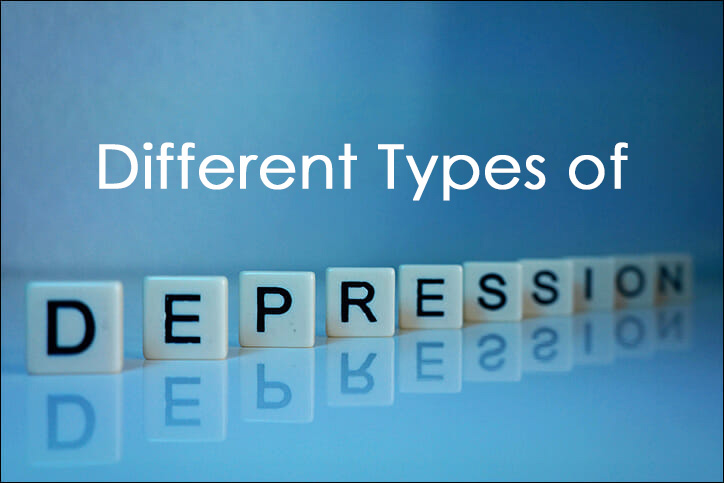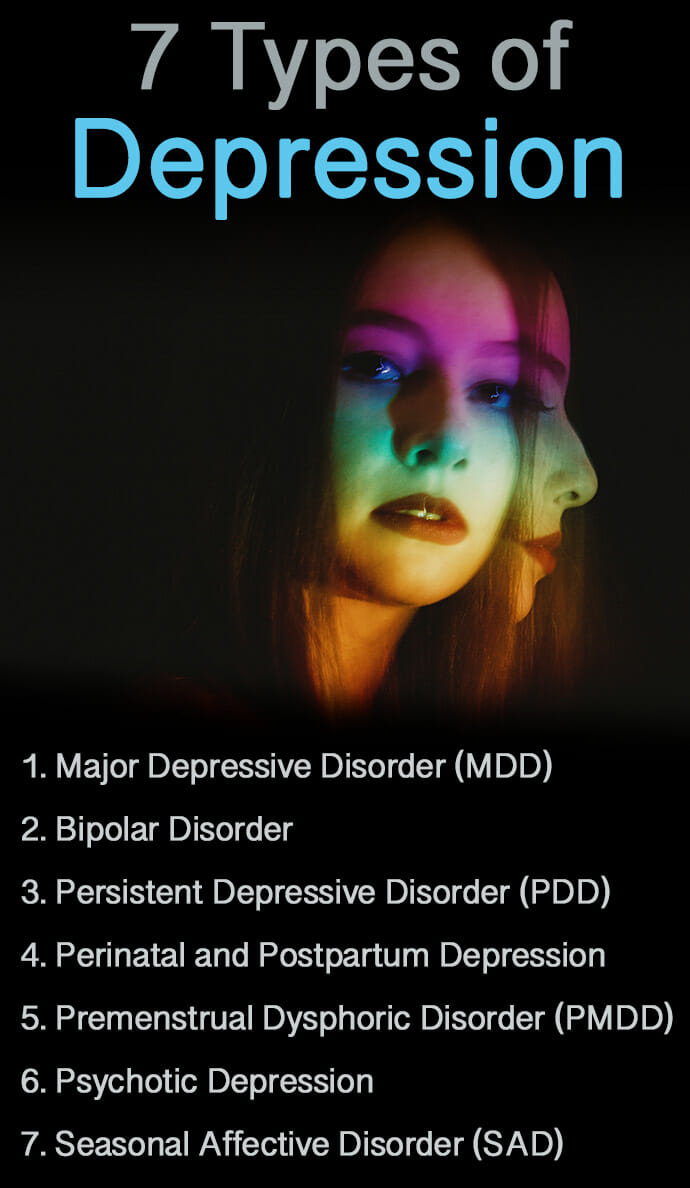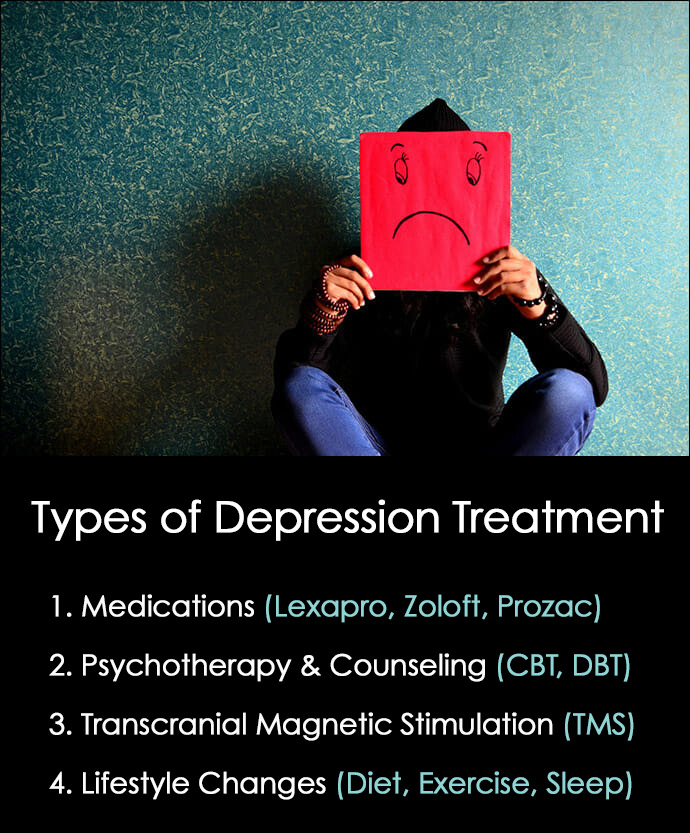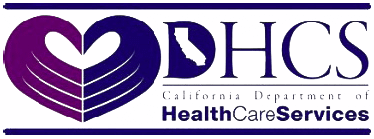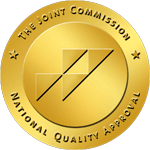Table of Contents
We’ve all experienced sadness and feelings of being depressed periodically, but there are different types of depression.
If the feelings last for more than a short time or appear regularly, it may be necessary to get a proper diagnosis and treatment.
Even though people are now more aware of depression as a mental health disorder than ever before, they might not know how prevalent the condition is.
According to the National Institute of Mental Health, around 21 million people suffered a major depressive episode in 2020, which is more than eight percent of the U.S. population.
That number skyrockets when considering how many people will battle depression in their lifetime.
Not all depression is the same, which is why it’s important to understand some of the various types of depression.
What is Depression?
In short, depression is mental health disorder with symptoms that range from mild to severe and causes feelings of hopelessness, worthlessness, and anxiety, among others.
Beyond just feelings, depression can lead to problems with sleeping, eating, memory, and the ability to concentrate.
As the symptoms pile up, they can seriously impair a person’s ability to function in their daily life.
Many people struggling with most kinds of depression find that they’ve lost interest in activities, places, or relationships they once enjoyed and begin to withdraw from their normal life.
Without treatment, the condition can worsen, last longer, and lead to drug or alcohol abuse, self-harm, and even suicide in severe cases.
Treatment for different types of depression can be incredibly effective for learning how to stop ruminating and obsessing about negative thoughts.
What are 7 Types of Depression?
The most common 7 types of depression are classified according to their symptoms and, in some cases, the cause of the condition.
That said, depressive episodes do not always have a clear cause and can last longer for some people than others.
7 Types of Depression
1. Major Depressive Disorder (MDD)
Major Depressive Disorder (MDD) is often referred to as “clinical depression” and severely impacts a person’s ability to function in daily life, with sometimes overwhelming symptoms that last for longer than two weeks.
When most people talk about depression, they are usually referring to major depressive disorder.
2. Bipolar Disorder
Bipolar Disorder is a mental health condition characterized by alternating bouts of extremely low, depressive moods and periods of intense energy and mania.
The depressive episodes typically include feelings of sadness, loneliness, and hopelessness, combined with a severe dip in physical energy.
There are different types of bipolar and the causes and symptoms will vary for each person.
The Depression and Bipolar Support Alliance (DBSA) states that nearly 5.7 million adults in the United States struggle with bipolar disorder each year.
Nobody is immune to this type of depression and some celebrities with bipolar have been outspoken about how treatment has positively impacted their lives.
3. Persistent Depressive Disorder (PDD)
Persistent Depressive Disorder (PDD) was previously referred to as “dysthymia,” and the symptoms are less overwhelming than major depressive disorder. PDD tends to have symptoms that last for two years or longer.
Because persistent depressive disorder is not as severe as major depression, some people call it high functioning depression due to its less debilitating nature, although that term is not an actual diagnosis.
4. Perinatal and Postpartum Depression
Perinatal and Postpartum Depression is a condition that occurs with the onset of depressive symptoms either during pregnancy or up to a year after giving birth.
With this type of depression, the symptoms are typically more serious than just minor feelings of stress, worry, or sadness.
5. Premenstrual Dysphoric Disorder (PMDD)
Premenstrual Dysphoric Disorder (PMDD) is a more serious form of a common condition known as premenstrual disorder.
With PMDD, the onset of symptoms occur in the days or weeks leading up to the menstrual period and can impair the ability to carry out normal daily functions.
6. Psychotic Depression
Psychotic Depression is a type of depression marked by very serious symptoms of depression, along with hallucinations that include seeing, hearing, or feeling things that are not there.
Psychotic Depression can also include delusions, which are beliefs not grounded in reality.
7. Seasonal Affective Disorder (SAD)
Seasonal Affective Disorder (SAD) is sometimes referred to as “seasonal depression,” and most people who experience this type of depression have the onset of symptoms in late fall and winter, when there is less sunlight.
Most seasonal depression symptoms tend to lessen during the summer and spring months when the days become longer and people spend more time outside soaking up sunshine.
Other Types of Depression
The 7 types of depression listed above are the most diagnosed, although there are others that either fit outside of diagnostic criteria or are included within those already mentioned.
Some of these include:
- Situational Depression
- Atypical Depression
- Treatment Resistant Depression
- Cyclothymic Disorder
- Melancholic Depression
DSM-5 Diagnostic Criteria for the Types of Depression
The Diagnostic and Statistical Manual of Mental Disorders, DSM-5, is the mostly widely used psychiatric manual in the United States.
For most types of depression, the DSM-5 outlines the primary criteria needed for an official diagnosis, which include the following:
- Depressed mood for the better part of a day, almost every day
- Significant loss of interest or enjoyment in most activities, nearly every day
- Changes in weight, either losing weight from a loss of appetite, or gaining weight due to an increase of appetite. Both markers must be present on most days
- An observable reduction of physical movement, as well as noticeable slowing of thought
- Exhaustion, fatigue, and loss of energy on most days
- Excessive feelings of guilt and worthlessness on most days
- An interrupted ability to concentrate, focus, or make decisions on most days
- Repeated thoughts of suicide, ideations of suicide without a specific plan, a suicide attempt, or a specific plan is made regarding suicide
These symptoms must be present for at least two weeks for a diagnosis of depression, as well as cause a person significant impairment at work, school, or other areas.
Finally, these symptoms cannot be the result of a medical condition, or as a result of drug or alcohol use, known as a substance induced mood disorder.
Types of Depression Treatment
Despite how common the different types of depression are, many people will ignore their symptoms or attribute them to something unrelated.
In very serious cases of depression, this can be life-threatening if a person is struggling with suicidal thoughts.
A primary care physician can often make a diagnosis of depression and provide treatment options.
However, if depressive symptoms do not go away after four to eight weeks, a primary care physician may recommend a psychiatrist.
Treatment Approaches for Most Types of Depression include:
Antidepressant Medications
The most common antidepressant medications are selective serotonin reuptake inhibitors (SSRI’s), such as prescription drugs like Lexapro, Paxil, Zoloft, or Prozac.
These medications help regulate the amount of serotonin in a person’s body and help reduce depressive symptoms.
Certain medications for anxiety and other types of prescription drugs are effective for different kinds of depression depending on the symptoms, causes, and duration.
Psychotherapy and Counseling
Psychotherapy and counseling combined with medication has shown to be very effective, although one-on-one counseling by itself may also help a person move through minor depressive symptoms.
Therapeutic approaches often include Cognitive Behavioral Therapy (CBT), which challenges negative thought patterns that are typical of depression.
CBT techniques help patients learn new ways of thinking positively and focusing on the present instead of the past.
Other evidence-based behavioral therapies like Dialectical Behavior Therapy (DBT) have also shown to be successful for treating various types of depression.
DBT therapy techniques teach skills like Mindfulness, Distress Tolerance, and Emotional Regulation that are beneficial for recovery.
Transcranial Magnetic Stimulation (TMS)
Transcranial Magnetic Stimulation, also known as TMS Therapy, uses magnetic pulses to stimulate parts of the brain responsible for mood. It is FDA approved as a safe, non-invasive depression treatment.
TMS Therapy is an option for people with treatment-resistant depression after several rounds of medications have failed to provide relief for the symptoms.
Lifestyle Changes – Diet, Exercise, and Sleep
Lifestyle changes are often overlooked by people with many types of depression, and they can be quite effective for overcoming the symptoms.
Simple changes to daily life, including diet, exercise, and proper sleep habits, can have an enormous impact on a person’s depressive symptoms.
A healthy, well-balanced diet of lean proteins, fresh fruits, and vegetables helps people avoid spikes and dips in blood sugar that have an impact on emotions.
Some foods that increase serotonin are especially helpful for improving mood.
Exercise helps reduce symptoms of stress and worry by naturally increasing the production of feel-good neurotransmitters in the brain.
Both diet and exercise also assist the body in getting proper sleep, the lack of which can have a serious impact on mood regulation.
The information provided here is a simple overview of 7 types of depression, along with how the condition is diagnosed and treated.
For anyone prone to frequent or lasting depressive symptoms, it is recommended to speak with a doctor as soon as possible to get a proper diagnosis and treatment before it progresses.
Frequently Asked Questions
What type of disorder is depression?
Depression is classified as a mood disorder.
Mood disorders are a mental health condition that affects a person’s mood, emotions, and impairs their ability to function normally on a daily basis.
How many types of depression are there?
Many mental health organizations and clinical resources recognize 6 to 10 main types of depression, although there are many more subtypes and related conditions with overlapping symptoms.
- Major Depressive Disorder (MDD)
- Bipolar Disorder
- Persistent Depressive Disorder (Dysthymia)
- Perinatal and Postpartum Depression
- Premenstrual Dysphoric Disorder (PMDD)
- Psychotic Depression
- Seasonal Affective Disorder (SAD)
- Melancholic Depression
- Cyclothymic Disorder
- Atypical Depression
What are the most common types of depressive disorders?
Major Depressive Disorder is generally considered the most common type of depression and is a leading cause of disability. It affects over 20 million adults in the United States each year.
Other common depressive disorders include:
- Bipolar Disorder
- Seasonal Affective Disorder
- Persistent Depressive Disorder
- Perinatal and Postpartum Depression
- Premenstrual Dysphoric Disorder
What is the worst type of depression?
Psychotic Depression is usually considered the worst type of depression because it combines general depressive symptoms of continued sadness with psychotic symptoms of delusions and hallucinations.
The severity and intensity of psychotic symptoms can be debilitating and may require hospitalization. Self-harm and suicidal ideations are risk factors associated with psychotic depression.
In addition, treatment-resistant depression can also be problematic. This condition occurs when traditional methods of treatment such as psychotherapy and medications fail to provide relief from the symptoms.
How do I know what type of depression I have?
The most accurate way of determining what type of depression you have is to get a proper assessment from a qualified healthcare provider.
A primary care physician or psychiatrist will review your medical history, symptoms, and ask you to complete a mental health questionnaire.
It’s also common to have a physical examination and lab tests.
Your doctor will consult the Diagnostic and Statistical Manual of Mental Disorders (DSM-5) to compare your symptoms to a list of conditions to determine the most appropriate diagnosis.
What type of therapy is best for depression?
There are many types of evidence-based therapies for depression.
Identifying the best one will vary depending on the depression type, severity and duration of symptoms, and the individual needs and preferences for each person.
Effective therapies for depression include:
- Cognitive Behavioral Therapy (CBT)
- Dialectical Behavior Therapy (DBT)
- Mindfulness-Based Cognitive Therapy (MBCT)
- Psychodynamic Therapy
- Transcranial Magnetic Stimulation (TMS) for treatment-resistant depression
